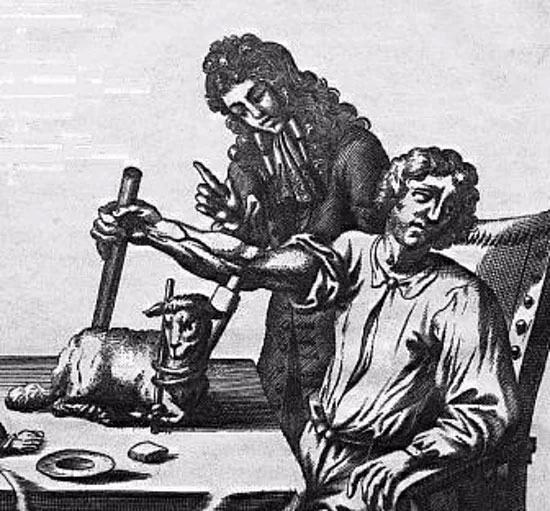History of hematology
Many blood transfusion experiments were conducted over the three decades before blood type and blood transfusion principles were discovered by scientists .
The history of blood transfusion began in the 1600s when British scientist William Harvey discovered that blood circulated through the heart instead of the lungs. With this knowledge, doctors reason that blood transfusions can help treat many conditions, such as postpartum haemorrhage, even mental illness. The first blood transfusions in history were also performed around this time, but most of them were unsuccessful, the blood recipient died.
British and American doctors also experimented with blood transfusion between animals. In 1666, the first blood transfusion between animals was successful.
In 1667, French doctor Jean-Baptiste Denis conducted 350ml of sheep blood for a 16-year-old boy with severe blood loss. After the transfusion, the boy's health was somewhat more stable, Jean said that his method of blood transfusion was effective. Of course, human blood and sheep blood were not compatible, the boy was lucky to survive because the amount of sheep blood transferred into the body was not large enough.

Jean-Baptiste Denis conducts sheep blood transfusion for patients.(Photo: Sutori).
Not long after that, with "success" from the first blood transfusion, Jean continued to conduct calf blood transfusion for a male patient with mental illness. He believes that male patients with bad blood should be replaced with good blood. If the blood transfusion from a gentle animal like calf, this mental patient will no longer act strangely.
However, after three blood transfusions, the patient exhibited symptoms of sweating, hands and skin under the arm burning, kidney damage, dark urine color turning and then death.
After the death of this patient, Dr. Jean was charged with criminal liability, blood transfusions were banned throughout France. Doctors and researchers also stopped blood transfusion until the 19th century.
In the 1800s, Dr. James Blundell discovered that blood could only be transmitted between animals of the same species. In 1818, he rescued a pregnant woman who had a haemorrhage after receiving a blood transfusion from her husband. He also performed another 10 blood transfusions during this period, but found that the success rate was not high and it was a risk. While some patients recover very quickly after a blood transfusion, the rest die within days.

Scientist Karl Landsteiner received the Nobel Prize in Medicine in 1930 after finding blood types.(Photo: India Today).
In 1901, the Austrian scientist Karl Landsteiner marked a memorable milestone in the history of medicine when he discovered that humans have three groups A, B, and O, classified by antigens on the red blood cell surface . At this point, scientists realized that the patients who died before were incompatible blood transfusion, causing blood clots leading to death. Appropriate blood type transfusion is important. Karl Landsteiner has opened up a new direction for hematology, the risk of death during transmission is almost gone.
In 1916, after the American Oswald Robertson demonstrated that blood could be stored and cooled, the number of transfusions increased significantly. In the 1940s, hundreds of blood transfusions were performed every day, the number of blood banks increasing. In recognition of his great contribution to medicine, Karl Landsteiner was awarded the Nobel Prize in Medicine in 1930.
- Understand the blood type and transfusion principles correctly
- What are the most common blood types in the world?
- National Scientific Conference on Hematology
- Bill Gates announced the Big History Project: History of 13.7 billion years of the universe
- Healing with umbilical cord blood
- Details of the three most dynamic stories of human history
- How much blood does the human body contain?
- Find out the darkest period in history, all kinds of disasters pouring down on humanity
- Earth History through images (Part II)
- 10 interesting facts about world history
- Back in history, learn about the origin of tea
- Top 10 major influential cities in history
- Successful treatment of blood cancer with stem cells
- The first chart about the entire history of the world
 Biography of hero Vu A Dinh
Biography of hero Vu A Dinh Who is Mr. Tam Da 'Phuc-Loc-Tho' and what does it mean?
Who is Mr. Tam Da 'Phuc-Loc-Tho' and what does it mean? Unbelievable facts about the history of the oil and gas industry: Gasoline used to be cheaper than water, so abundant that it had to be dumped into the river...
Unbelievable facts about the history of the oil and gas industry: Gasoline used to be cheaper than water, so abundant that it had to be dumped into the river... The history of the world's first closed diving suit
The history of the world's first closed diving suit